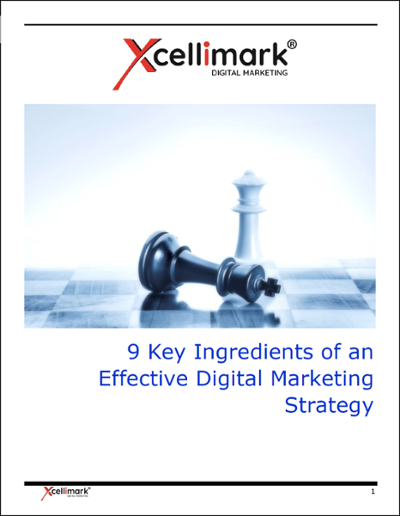
9 Key Ingredients of an Effective Digital Marketing Strategy
Read the Article Below and Download Your Personal Copy

Building an Effective Digital Marketing Strategy

Overview
Most people agree that developing an overall strategic plan and blueprint is critical before starting a construction project to build a house or road.
However, many business owners and marketing and sales executives fail to build an effective digital marketing strategy or plan to determine how they are going to achieve their business goals and objectives.
They simply launch marketing campaigns in hopes that their efforts will work.
Download This as an eBook
Click on the link below to download your own copy of the 9 Key Ingredients of an Effective Digital Marketing Strategy.
Download your EbookUse Your Resources to Reach Specific Goals
Often the campaigns do not work as intended, wasting time, money, and re0t a wall to see what sticks.
The purpose of your digital marketing strategy is to use your available resources (channels, tools, and people) to meet a specific goal.
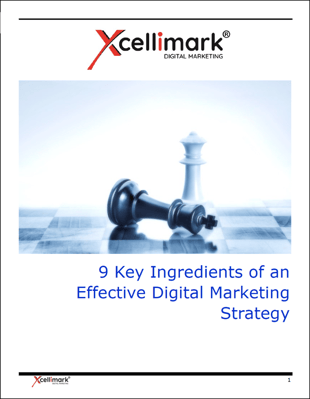
Building an Effective Digital Marketing Strategy
Let’s look at the top strategic priorities for digital marketing compared to the most challenging barriers to digital marketing success:
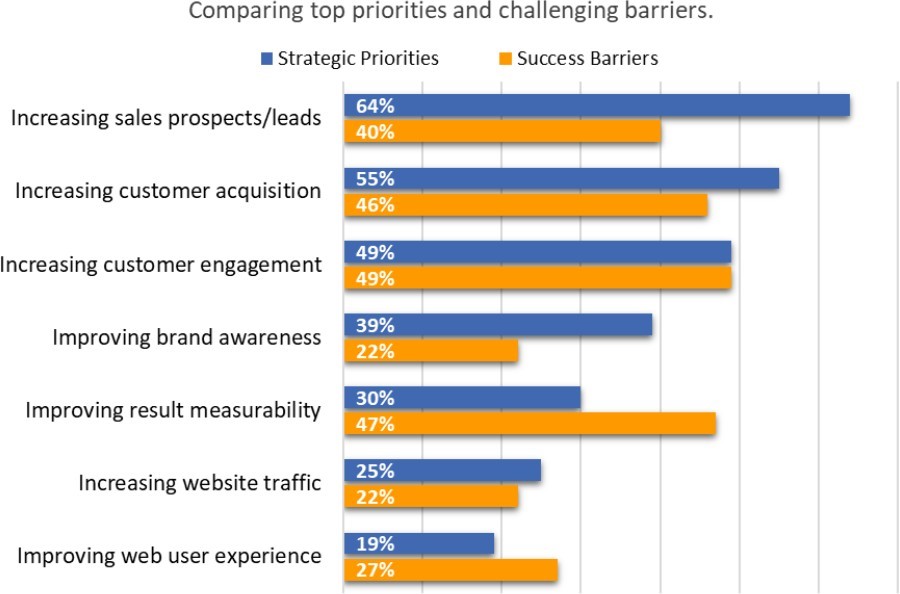
SMART Goals & Objectives

Start with an Executive’s Main Goal
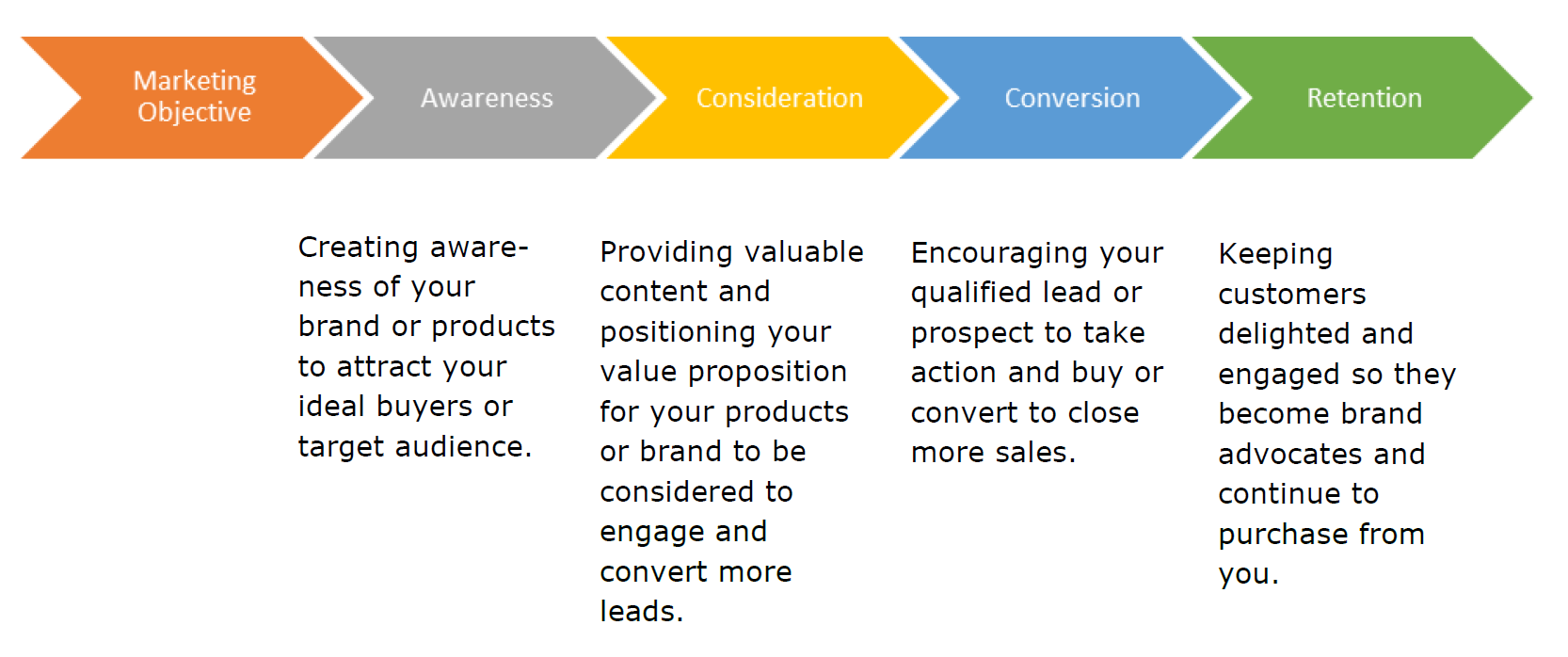
Growing your business or organization today is the #1 business goal for executives. Consequently, the goals of your digital marketing strategy need to focus on generating leads and prospects to create more sales opportunities.
Your sales team can then turn these opportunities into happy customers who will continue to engage with your company.
Your marketing objective to achieve your business goals should include these fundamentals:
Setting SMART Goals
The business goal that you set for your digital marketing campaigns should be SMART, meaning they are:
- Specific
Your goal should be clear and singular. Don’t use vague phrases such as “we want more site traffic and positive reviews.” Yes, you want that, but you should choose a specific metric you want to improve upon the most, such as website visitors, leads, or new customers.
- Measurable
You need to be able to track and measure key activities that are part of your quantifiable goal. For example, you could say that you want to achieve an X percent increase in visitors, leads, or customers.
- Attainable
Your goal must be feasible given your circumstances and the resources available to you. If your website traffic increased 5% last month, then it may not be realistic or attainable to set a goal to increase it organically by 25% the next month.
- Realistic
Your goal should be realistic, relevant, and achievable for your business or organization. It needs to be relevant to your overall company or organizational goal(s) so that achieving your digital marketing goal has a relevant and measurable impact on your overall goal(s).
- Timely
Your goal should include a timeline to achieve it. Setting timelines helps you to stay focused on achieving the goal and your progress in achieving it.
Goal vs. Strategy vs. Tactics
Determining the difference between a goal, strategy, and tactic can be confusing for many people. We have identified the attributes of SMART goals. Digital strategies govern how digital is used to achieve your SMART goals. Tactics are individual activities or executions that are used as part of a strategy.
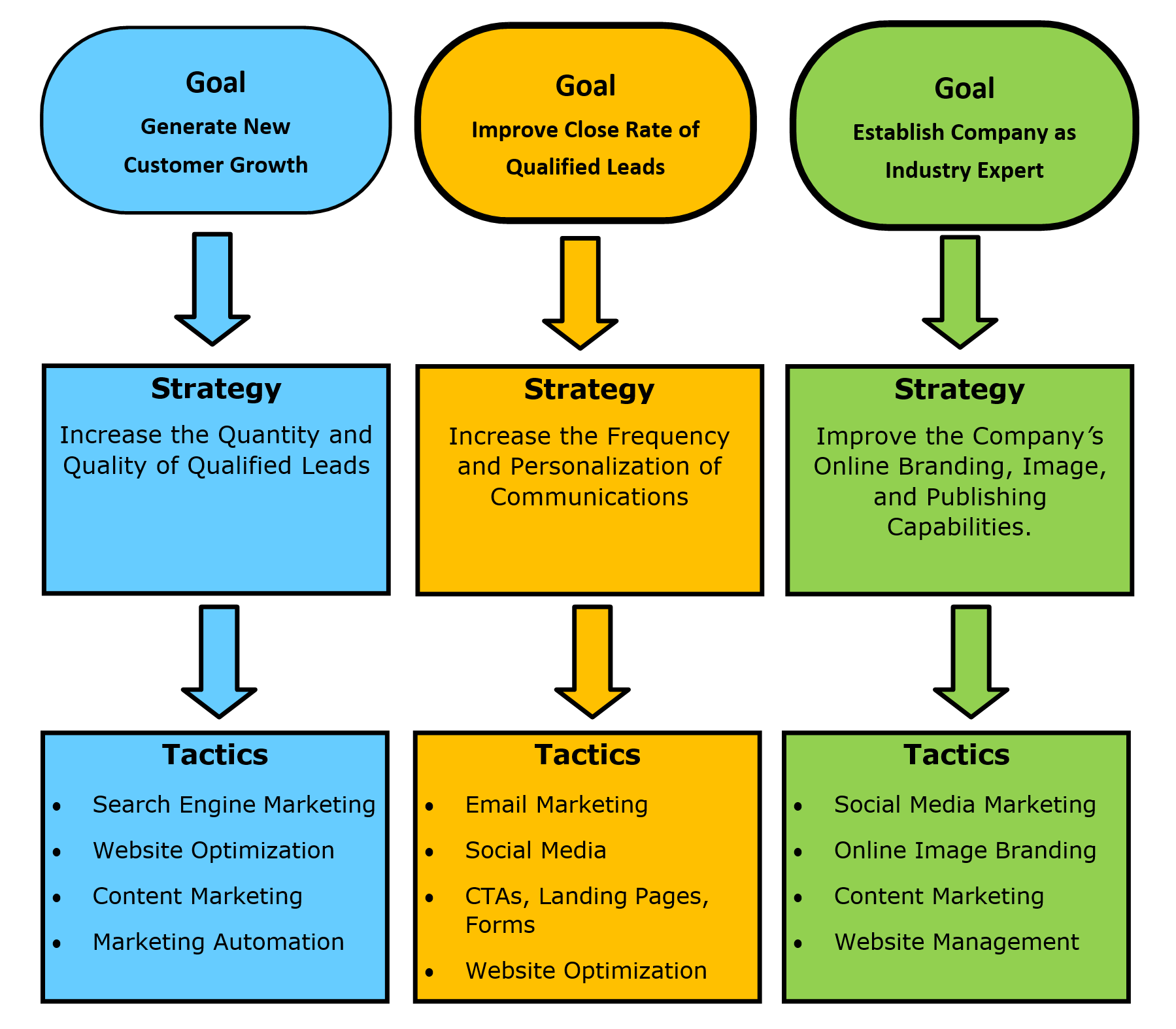
Setting Objectives
When developing a strategy to achieve a goal, you need to set clear and concise objectives that are specific to your business. For example, if your goal is to increase revenue by $5 million this year, then your objectives could be to increase sales by X percent this year, drive X percent more leads each quarter, or build audience engagement with your brand by X percent within the next 6 months.
The objectives are the milestones you need to reach in order to achieve your goal. Knowing and establishing the Key Performance Indicators that you need to track and measure your objectives is critical to this process.
So let’s say your goal is to generate new customer growth by 15% within the next three (3) months.
While tracking and measuring your sales to meet this goal, there are also other KPIs that you should measure to help keep track of your progress in meeting your goal.
You will want to track and measure your traffic, leads generated, sales proposals presented, and revenue value of each sales proposal.
There should be an objective set for each of those KPIs so you can measure your success against your objectives.
KPIs should be tracked based upon the tactics used such as:
- Search engine traffic generated
through PPC Ads and SEO that resulted in conversions to leads on your website.
- Actions and activities performed by your leads as they progress through their buyers’ journey. These actions and activities can be tracked in emails opened, articles read, and content downloads that have increased the quality of your leads.
- Display and social media engagement used to create awareness. Awareness can be tracked as part of your marketing reach and engagement, such as social media click-throughs to your blog articles that result in content downloads that generate leads.
As mentioned earlier, Key Performance Indicators are important metrics that measure the performance and effectiveness of your content, channels, and tactics in achieving your goals.
Typically, KPIs are tracked and measured by a range of digital tools such as Google Analytics, Marketing Automation Platforms, and CRM platforms.
Some examples of KPIs for your search engine marketing tactics (PPC and SEO) are:
-
Website traffic generated
-
Number of website conversions to leads (aka conversion rate)
-
Cost-Per-Conversion or Lead (CPL)
-
Percent of leads presented with a sales proposal or quote
-
Average revenue per proposal
-
Sales Closed
-
Average sales revenue per sale
It is also important to identify who is responsible for tracking the KPIs and meeting the objectives. Responsibility may span multiple people or departments including outside resources hired to help you achieve your overall goal.
Some examples of responsible parties include:
- Marketing
Responsible for determining a market strategy, creating awareness, generating website traffic, and generating leads.
- Sales
Responsible for engaging leads, presenting sales proposals, and closing sales.
- Customer Service
Responsible for product and service delivery including customer satisfaction, referrals, testimonials, and reviews.
- Public Relations
Responsible for establishing company image, reach, and sentiment.
- Product Development
Responsible for product or service development to best fit the needs of a specific buyer persona.
- Executive
Responsible for adequate budget and deployment of resources.
Digital Strategy Research

Engaging in Digital Research
Once you have established your overall goal, you need to engage in digital research to learn as much as possible before developing a strategy. Research is critical in order to learn more about your current marketing processes, market demand for your products and services, target market profile, competition, and industry.
While you will likely need to make some assumptions as part of setting your objectives, you’ll want to minimize the “guesswork” on the outcomes of your digital marketing and sales efforts.
Your digital strategy research should include:
- Marketing and Sales Assessment
Conduct a thorough assessment of your marketing and sales practices, processes, performance metrics, and tools being used by your marketing, sales, and potentially customer service teams. Identify any gaps and areas for improvement
- Market Demand Analysis
Identify the search demand for the most relevant keywords being used in search engines such as Google to determine how many people are searching for your products and services every month. You also want to establish the cost for Paid Ad campaigns and the resulting traffic you would generate from these campaigns.
- Market Influencer Analysis
Identify Key Influencers who are producing the most popular content related to your business on social media.
- Digital Audit
Conduct an assessment of the active sites, pages, profiles, and accounts you have in existence and who manages them.
- Buyer Persona Development
Develop detailed profiles of your most ideal buyers. These profiles should include:
- Priority Initiatives - What are the trigger events that cause them to start looking for solutions to a problem? What are their priorities and why did they make a change?
- Success Factors – What are the results they expect from a product or service? What is a “successful” experience
- Perceived Barriers – What are their perceived barriers to choosing you?
- Decision Criteria – What attributes will they use as decision criteria to evaluate or compare alternatives to your solution or to do nothing
- Evaluation Journey – What is their decision-making process? What is this person’s role in that process?
- Priority Initiatives - What are the trigger events that cause them to start looking for solutions to a problem? What are their priorities and why did they make a change?
- Content Analysis
Identify the most sought-after information or content throughout the different stages of the Buyer’s Evaluation Journey and the most popular content published on your products and services.
- Competitive Analysis
Analyze your top competition to determine what they are doing in their digital marketing activities and how well they are doing it. What is their value proposition and how well are they differentiating themselves in your industry?
The results of your digital strategy research will be used to create an assessment document which will in turn be used to develop your strategies for your digital channels, content, media, and inbound marketing.
A Digital Channel Strategy

Determine Which Channels Your Ideal Buyer Uses
Your ideal buyers, key influencers, and other target audiences will utilize and engage in a range of digital channels such as search engines, social media, email, display ads, and video platforms.
It is important to determine which channels are a key part of your digital marketing strategy and the content types and formats used to attract and engage your target audiences through each digital channel.
Digital marketing helps you attract your target audience by publishing and distributing content through digital channels to make them aware of your brand as they conduct their research and education online.
According to the Google ZMOT study, 84% of buyers engage in online information consumption and education.
Each channel has its strengths and weaknesses, content formats, limitations, costs, and benefits. Businesses and organizations should pursue a multi-channel approach so they are creating awareness of their brand or product through multiple digital channels.

Primary digital channels include:
- Search Engine Optimization (SEO)
Being listed and highly ranked in organic search engine results is key because it leads to discovery, awareness, interest, and conversion without a paid advertising effort.
SEO is a complex tactic that has many variables that contribute to your website ranking and exposure including:
- depth and quality of content
- incoming links to your website
- domain authority
- social bookmarking
- whether your website is mobile friendly
- having a secure website (SSL)
Exposure through ranking high (page 1) in Google’s search engine result pages (SERP) is the key to generating leads for your business.
- Paid Search (Pay-Per-Click, PPC)
These are advertisements (aka sponsored ads) listed in search engine result pages.
Paid Search is a great channel for specific keywords that are highly related to your brand, products, and services. Your ads can be positioned in front of people actively looking for solutions that you provide.
The cost of your ads is based upon several factors including the amount you are willing to pay for each click and the relevancy of your landing page once someone clicks on your ad.
This channel can bring you high-value traffic from an interested audience. Search channels include Google, Bing, DuckDuckGo, Wiki.com, and others.
- Display Advertising
These forms of advertising allows you to display your ads in front of your target audience based on your audiences’ interests, age, gender, community, keywords, and more.
These ads are displayed across specific websites or a range of websites that your audience is engaging with online.
Prominent display ad networks include Google Ads, Media.net, Facebook Audience Network, Verizon Media, Infolinks, Apple Advertising, Adknowledge, Native & Search, Taboola, and many others.
- Email Marketing
Sending emails and automating follow-up processes are used primarily to engage prospects, leads, and customers that are part of your network.
Emails can be used in a variety of campaigns and typically include list segmentation, subject lines, email copy, Calls-To-Action (CTAs), links to website pages and landing pages, and analytics.
Common objectives include raising interest, converting leads to customers, and retaining customers by providing additional value to the brand, product, or service.
- Social Media Marketing
Social media platforms are primarily used for creating awareness and interest through content and social engagement.
Advertising is also available based on display advertising attributes previously mentioned.
Prominent social media channels include Facebook, Twitter, LinkedIn, Pinterest, Instagram, YouTube, and Snapchat.
- Video Ad Networks
Video is one of the most popular forms of content. While video is a form or type of content, there are video networks worth mentioning for consideration.
Video advertising is exploding across every type of market and industry. Cisco estimates that 80% of all internet traffic by the end of 2019 will be video content.
Popular video ad networks include YouTube (Google), Verizon Media Group, SpotX, Springserve, and Airpush.
- Website Optimization
Optimizing your website is critical to engaging and educating website visitors. Educational content with Calls-to-Action will motivate visitors to take action on your website such as signing up for a newsletter, downloading a content offer (ebook, guide, white paper, case study, lists, etc.), signing up for a podcast or seminar, requesting a consultation or quote , purchasing a product, and becoming a customer.
While images and design are important, your content is key to attracting, engaging, and converting your target audience from strangers to prospects to leads to customers.
Optimization efforts should include loading speed, reliability, navigation, responsiveness, content, security, and conversion processes. These efforts will deliver a better user experience, drive more actions, and create better performance.
Content Marketing Strategy

What Is Content Marketing?
While digital channels are your pathways to reach your target audience, your content is the blood that flows through the veins of all marketing.
“Content marketing is defined as a marketing technique of creating and distributing relevant and valuable content to attract, acquire, and engage a clearly-defined and understood target audience – with the objective of driving profitable customer action.”
- Joe Pulizzi, Content Marketing Institute
Consider how your ideal customer currently researches and engages online based on the following research:
- Consumers are 5x more dependent on content than they were 5 years ago (Nielsen)
- Consumers engage with 11.4 pieces of content before making a purchase decision (Forrester)
- 70-90% of the buyer’s journey is complete BEFORE a buyer contacts a sales representative (Forrester)
Salespeople are no longer in complete control of the education and sales process of a prospect. Salespeople may still close the deal, but that assumes they get the call in the first place.
As the research outlines above, your ideal customer has already conducted their investigation online and determined who will get the call based upon who gave the best and most complete information they sought and consumed throughout their buyer's journey or decision-making process.
Based on your digital research and knowledge of your ideal buyers, your content strategy should outline:
- Each piece of content to be created
- The content type
- The specific digital channel where it will be published
Your content strategy should include the following:
- Creative Strategy for the visual stimulation that will motivate your target audience to want to learn more about your brand, product, or service.
Your Creative Strategy should include:
- Ideas around your various content types, formats, and messaging.
- How you will encourage your target audience to engage with you.
- Creative guidelines or style guides for your visual elements such as logo, color schemes, video, and branding elements.
- A narrative of your brand story explaining why do you do what you do.
- Ideas around your various content types, formats, and messaging.
- Value Proposition that is clear, concise, and supported by evidence (awards, memberships, associations, testimonials, reviews, case studies, etc.) throughout your website that identifies the specific elements that differentiate you from your competition, and why visitors should do business with you. Learn more about creating a killer value proposition here.
- The Content Plan that determines the specific content that needs to be created and published over a specific period of time. For example, what website pages, blog articles, press releases, guides, white papers, case studies, social media posts, and videos are to be created, who will be creating the content, and details of the copy, format, and channels.
Media Strategy
Determine Your Media Buys & Resources
A media plan will determine how you plan to spend an Ad budget with details on the advertising platform, budget, KPIs, tracking, and estimates on reach, impressions, and clicks to a destination website page or custom landing page.
Pricing for Ads will vary based on cost-per-thousand impressions (CPM), cost- per-click (CPC), or in some cases cost-per-lead or acquisition (CPL or CPA).
Details on these plans are typically listed and updated in a spreadsheet such as Excel that may also include initial assumptions on budget, clicks, conversions, leads generated, sales opportunities, closed sales, sales revenue, cost-per-lead, cost-per-sale, and ROI.
Identify the resources needed for your media campaigns along with the ad platform.
Resources can include in-house or agency specialists for PPC, social media, display, video, email, PR, design, copy, analysis, technology, and strategy.
Inbound Marketing Strategy

Attract Qualified Prospects
You need a proven methodology for implementing and managing your digital marketing strategy and plans. It’s up to marketing to do a much better job online to identify, create, and deliver information their prospects or buyer personas seek and consume as part of their buying or decision-making process.
By creating the content specifically designed to appeal to your ideal customers, Inbound Marketing allows you to attract qualified prospects to your business and keep them coming back for more.
Inbound Marketing continues to expand, however, extending its methodology into sales and customer service.
In the past, we thought of marketing funnels and sales funnels as two separate items and it worked for some time.
But viewing your progress as a funnel causes you to lose momentum and customer intelligence.
In the past, Marketing stopped what they were doing when they reached the end of the marketing funnel. That was when the Sales team took over.
Sales teams then stopped at the end of the sales funnel. It was no longer their responsibility to deal with a customer.
Customer Service or Operations then took over. However, the Customer Service and Operations teams rarely knew much about the customer’s buyer journey and the sales experience that led them down the path to become a customer.
It is actually a very good thing for the Customer Service and Operations people to know the key issues that were addressed and what the factors were that lead to a customer making the decision to buy.
Therefore, the Inbound methodology has evolved from a Funnel to a Flywheel.
The Flywheel is a better model in today’s digital ecosystem because it builds an integrated process that puts the customers first.
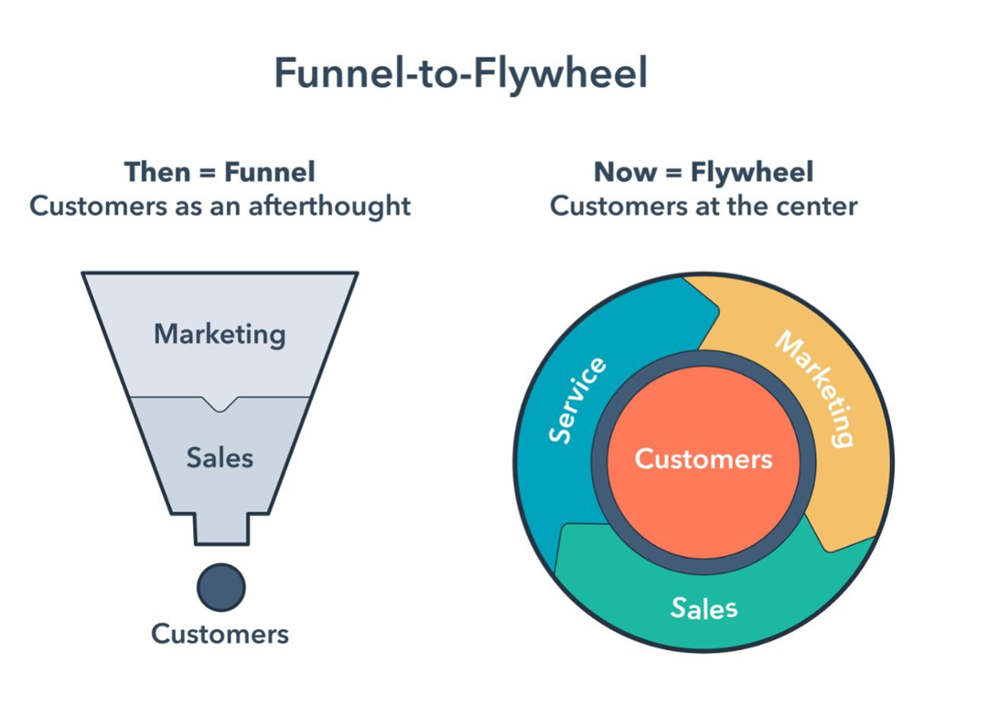
Attract Qualified Prospects
-
Attract leads by earning your target audiences’ attention. You can attract visitors with valuable content in channels they prefer and eliminate barriers as they learn about your company and your products and services.
- Engage with your buyers on their preferred timeline and channels. Expand your incentives for your sales team to include customer success, not just closing a sale.
-
Delight your customers by ensuring adequate resources are available for them. The focus on the customer is distributed throughout the entire customer experience by Marketing, Sales, Customer Service, and Operations.
- Customer satisfaction is the key to business growth. If all your teams are not aligned and working to minimize friction for your customers, the whole company loses momentum.
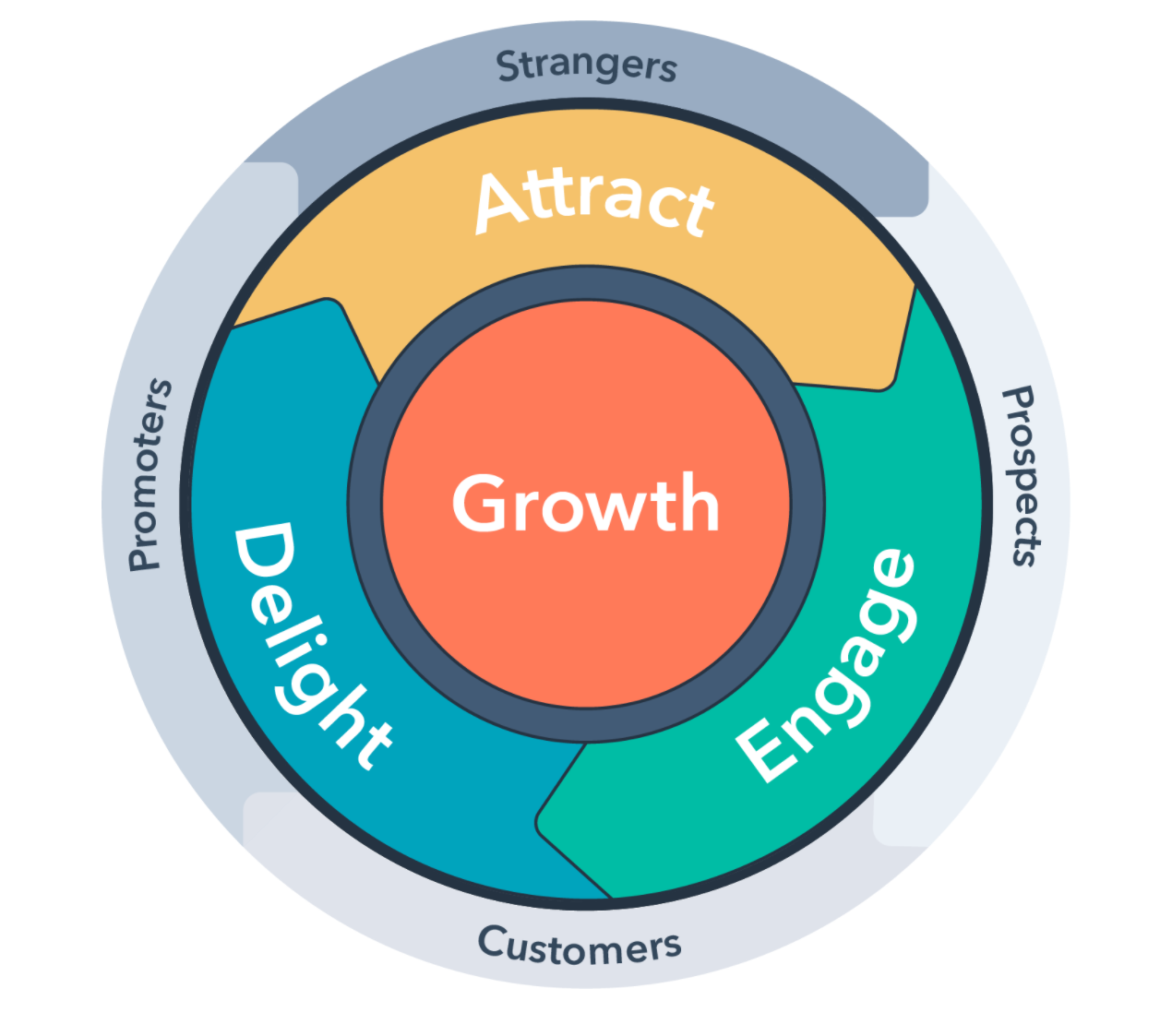
Today, 57% of the B2B purchase processes are completed before buyers reach out to vendors.
You don’t control the sales process anymore, the buyer does. They are doing their education online at the pace and time they prefer. They check out third party review websites, and seek peer and friends’ recommendations.
Word-of-mouth recommendations still play a significant role in purchase decisions. Consumers and business people ask their network of friends, associates, and family for advice and then search for mentions of your company on social media.
Your customer base is also a great way to grow more customers.
Interact with your customers when and how they engage with you. Grow your company by applying force to the strongest areas of your business and eliminate any friction that gets in the way that may have a negative impact on your customers.
Analytics

Collect, Measure, and Analyze Your Website Data
Digital analytics provides the collection, measurement, and analysis of website data. You can use this data to optimize the performance of your digital channels, understand how users are consuming your content, and understand the performance of your digital marketing campaigns. It allows you to analyze and make informed decisions to improve the performance of your digital efforts based on data.
Other benefits include:
- The ability to better understand and get closer to your users and customers.
- The ability to forecast using trends and patterns in user behavior.
- The opportunity to gain key insights from your users and customer activity.
- Accountability and tracking of media spend and resource allocation.
- A better prioritization of resources.
- Higher conversion rates and improved quality of leads.
- A stronger focus on digital campaigns.
- A better understanding of costs and enhanced return-on-investment (ROI).
Creating, launching, and managing your digital campaigns without robust analytics puts you at risk of operating blindly, not really knowing what is working and what is not working.
We recommend that every website install Google Analytics, which is free. Google Analytics can provide key insights on an aggregate-overall basis.
We also recommend implementing additional analytics through a Marketing Automation Platform that gives you more insights into individual users and what they are doing throughout your campaigns and channels.
This allows you to personalize each visitor’s experience based on their previous actions. Digital marketing, sales, and service platforms such as HubSpot provide key insights that give you actionable intelligence to optimize all of your digital tactics, activities, and efforts.
Technology Plan

Create a Technology Strategy that Delivers ROI
Identifying the marketing, sales, and service activities and processes throughout a buyer’s journey requires an assessment of your technology tools being used to support your marketing, sales, and service activities.
To be effective and efficient in delivering business and customer growth, you need a technology strategy that:
- Streamlines and automates resource intensive processes
-
Tracks performance providing insights into the effectiveness and success of your marketing campaigns and sales efforts
-
Protects and secures personal information ensuring compliance with the growing range of state, national, and international privacy regulations
-
Ensures sharing of information across organizational teams that capture the complete customer experience
- Delivers a significant ROI
These days marketing and sales departments purchase and control as much technology as the IT department.
In fact, marketing technology will be the top investment for marketing departments in the next few years.
The average number of marketing technologies utilized in a company is 16 and range as high as 98 in larger organizations.
And that’s just the marketing department.
It appears that companies with tech-savvy executive teams and board of directors are growing, leading, and soon-to-be dominating in their markets.
Bottom line takeaway - marketing and sales teams must become tech-savvy.
Here is an example of the technology tools you will need across your marketing, sales, and service teams in order for them to share information throughout your customer's experience.
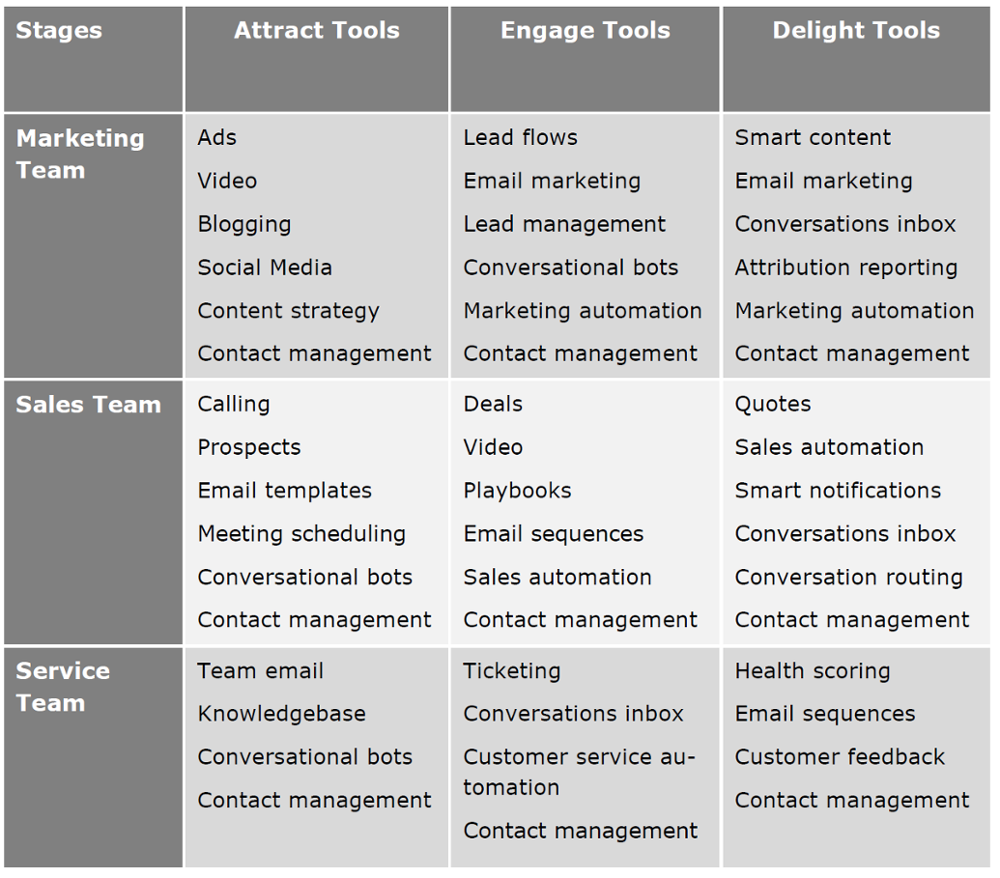
In Christopher Mims Wall Street Journal article, “Every Company Is Now a Tech Company,” he quoted Sean Sullivan, an angel investor credited with coining the phrase “cloud computing.”
Mr. Sullivan said,
“There is an existential threat to Fortune 500 companies before the end of this decade (this year). You can actually see companies that are less than 10 years old knocking off and surpassing companies that have been around for 100 years.”
Identifying the processes of a customer life cycle from marketing through sales through customer service is critical today.
It is impossible for an organization to interact effectively and efficiently throughout the life cycle of your customers’ experience with your business in a manual, paper-driven support system.
You must assess, acquire, and successfully implement the underlying technology to support these processes and the information flow that relates to your prospects, leads, and customers as they move through the buyer’s journey and interaction with all of your company’s touch points.
Digital Project Plan

Pull it All Together with a Digital Project Plan
Creating a strategy to deliver your business or organizational goal is achieved by understanding available resources, setting timelines and budget, looking at current and past activity, and assigning ownership of activities and KPIs to team members or stakeholders.
Managing digital marketing campaigns requires effective communications on what will be produced and implemented related to your:
- Content creation and marketing efforts
- Marketing campaigns across all digital channels
- Resource management for marketing campaigns
Your content marketing plan should outline what content will be produced and when. It should also identify the employee, contractor, or agency responsible for producing each piece of content including the review, editing, and approval process. It should identify the type of content, platform, and channels to be produced and published.
You will also want to identify the KPIs used to evaluate the success of each piece of content.
All marketing campaigns should be identified and listed including your channels, formats, timeline, budget, and KPIs used to evaluate the success of each campaign. The marketing campaign schedule will also include any media plans where you have allocated a budget for paid advertising.
Effective project management of your digital marketing campaigns is key to staying on track to launch campaigns as designed and on time.
Using project management tools that allow collaboration, task assignment, time management, status updates, and workflows that automate key processes is important.
Identifying, tracking, and managing the resources needed and utilized throughout the building, launching, and management of your marketing campaigns is key to your success.
Summary

Achieve Business Goals & Buyers Expectations
t’s important to remember that in today’s digital world, the controls are in the hands of buyers, not sellers. Buyers come to your website with very high expectations based on their collective digital experience with major brands and portals whose digital marketing budgets are in the millions of dollars annually.
That’s why successfully executing these nine (9) key ingredients for an effective digital marketing strategy is critical to ensuring your strategy achieves your business goals and addresses your buyers’ expectations.
Too often businesses and even digital marketing agencies are eager to jump in and start running campaigns without first thinking through their strategy.
Some tactics may work for a while but will eventually become less effective. Other tactics will fail very quickly, or the results cannot be easily determined, leaving you and your agency to guess what went wrong and why.
Taking a more comprehensive approach to developing your digital marketing strategy will take a little more time up front, but the outcomes of your campaigns will be far more effective.

